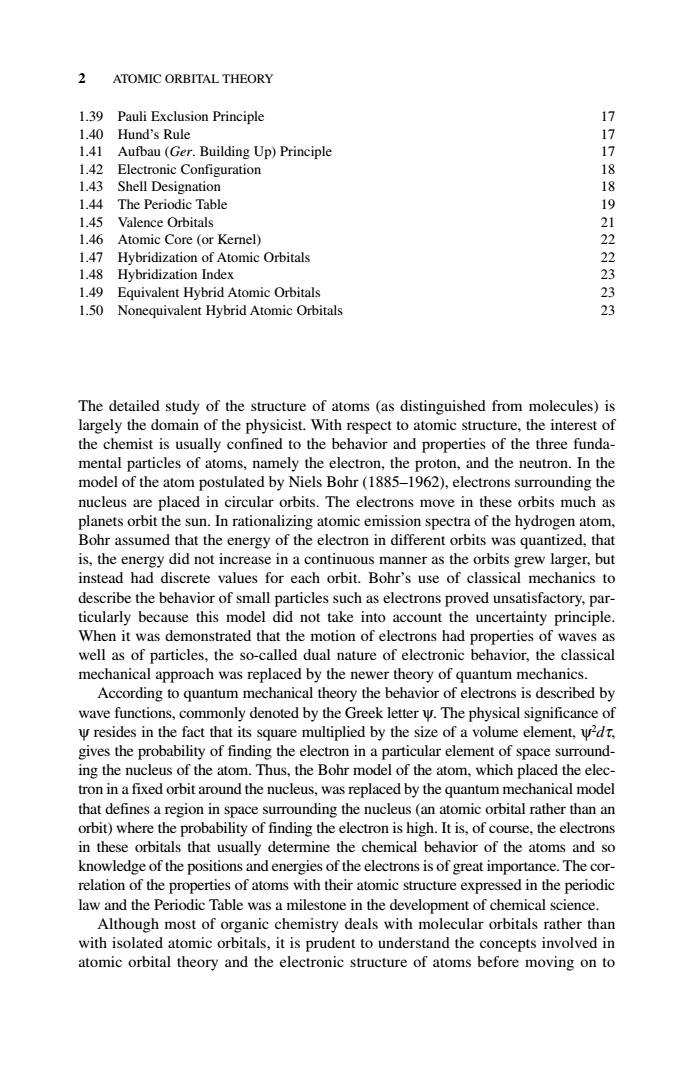正在加载图片...

2 ATOMIC ORBITAL THEORY 1.39 Pauli Exclusion Principle Hund's Rule Building Up)Principle 143 145 146 Atomic Co re(or Kemel) 1.47 Hybridization of Atomic Orbitals 778891223 1 48 Hybridization Index 1.49 Equivalent Hybrid Atomic Orbitals 1.50 Nonequivalent Hybrid Atomic Orbitals 23 The detailed study of the structure of atoms (as distinguished from molecules)is largely the domain of the physicist.With respect to atomic structure,the interest of the chemist is usually confined to the behavior and properties of the three funda- mental particles of atoms,namely the electron,the proton,and the neutron.In the model of the atom postulated by Niels Bohr(1885-1962),electrons surrounding the et The clectrons move in these orbits much mic emission that the ng ato spectra of the hydrog en atom ectron in different as quann d tha is,the ene d not I eas in a instead had nner as th v larg r,bu describe the behavior of small particles such as electrons proved unsatisfactory,par- ticularly because this model did not take into account the uncertainty principle. When it was demonstrated that the motion of electrons had properties of waves as well as of particles,the so-called dual nature of electronic behavior,the classical mechanical approach was replaced by the newer theory of quantum mechanics According t quantum mechanical theory the behavior of elect ons is described by denoted by k le er .The phys Ψr es in ct that its square multiplied by the siz a volume element,d gives the probability of finding the electron in a partic lar elemen or space surounc ing the nucleus of the atom.Thus.the Bohr model of the atom.which placed the eled tron in a fixed orbit around the nucleus,was replaced by the quantum mechanical model that defines a region in space surrounding the nucleus(an atomic orbital rather than an orbit)where the probability of finding the electron is high.It is,of course,the electrons in these orbitals that usually determine the chemical behavior of the atoms and so knowledge of the positions ande ies of the electrons is of great imp rtance Thec relation of the sof atoms ato ic structure expre ed in the aw and the e was a milestone in the c velopment of che enc Although most of organic chemistry deals with molecular orbitals rather than with isolated atomic orbitals,it is prudent to understand the concepts involved in atomic orbital theory and the electronic structure of atoms before moving on to 1.39 Pauli Exclusion Principle 17 1.40 Hund’s Rule 17 1.41 Aufbau (Ger. Building Up) Principle 17 1.42 Electronic Configuration 18 1.43 Shell Designation 18 1.44 The Periodic Table 19 1.45 Valence Orbitals 21 1.46 Atomic Core (or Kernel) 22 1.47 Hybridization of Atomic Orbitals 22 1.48 Hybridization Index 23 1.49 Equivalent Hybrid Atomic Orbitals 23 1.50 Nonequivalent Hybrid Atomic Orbitals 23 The detailed study of the structure of atoms (as distinguished from molecules) is largely the domain of the physicist. With respect to atomic structure, the interest of the chemist is usually confined to the behavior and properties of the three fundamental particles of atoms, namely the electron, the proton, and the neutron. In the model of the atom postulated by Niels Bohr (1885–1962), electrons surrounding the nucleus are placed in circular orbits. The electrons move in these orbits much as planets orbit the sun. In rationalizing atomic emission spectra of the hydrogen atom, Bohr assumed that the energy of the electron in different orbits was quantized, that is, the energy did not increase in a continuous manner as the orbits grew larger, but instead had discrete values for each orbit. Bohr’s use of classical mechanics to describe the behavior of small particles such as electrons proved unsatisfactory, particularly because this model did not take into account the uncertainty principle. When it was demonstrated that the motion of electrons had properties of waves as well as of particles, the so-called dual nature of electronic behavior, the classical mechanical approach was replaced by the newer theory of quantum mechanics. According to quantum mechanical theory the behavior of electrons is described by wave functions, commonly denoted by the Greek letter ψ. The physical significance of ψ resides in the fact that its square multiplied by the size of a volume element, ψ2 dτ, gives the probability of finding the electron in a particular element of space surrounding the nucleus of the atom. Thus, the Bohr model of the atom, which placed the electron in a fixed orbit around the nucleus, was replaced by the quantum mechanical model that defines a region in space surrounding the nucleus (an atomic orbital rather than an orbit) where the probability of finding the electron is high. It is, of course, the electrons in these orbitals that usually determine the chemical behavior of the atoms and so knowledge of the positions and energies of the electrons is of great importance. The correlation of the properties of atoms with their atomic structure expressed in the periodic law and the Periodic Table was a milestone in the development of chemical science. Although most of organic chemistry deals with molecular orbitals rather than with isolated atomic orbitals, it is prudent to understand the concepts involved in atomic orbital theory and the electronic structure of atoms before moving on to 2 ATOMIC ORBITAL THEORY c01.qxd 5/17/2005 5:12 PM Page 2